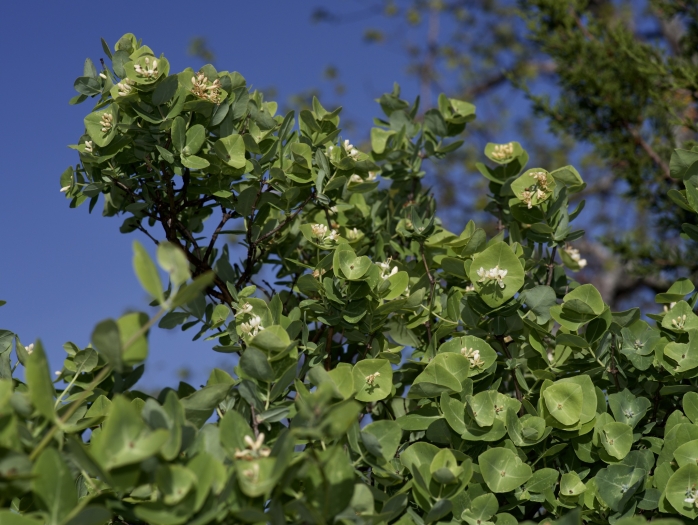Western White Honeysuckle
(Lonicera albiflora)
Western White Honeysuckle (Lonicera albiflora)
/
/

Michelle W.
CC BY 4.0
Image By:
Michelle W.
Recorded By:
Copyright:
CC BY 4.0
Copyright Notice:
Photo by: Michelle W. | License Type: CC BY 4.0 | License URL: http://creativecommons.org/licenses/by/4.0/ | Rights Holder: Michelle W. | Publisher: iNaturalist | Date Created: 2020-04-01T17:43:12-07:00 |






















































Estimated Native Range
Summary
Lonicera albiflora, commonly known as Western White Honeysuckle, is a deciduous shrub native to the Southwestern United States and Northwest Mexico, particularly thriving in chaparral, scrub, and forest edges as well as riparian zones. It typically grows to a height of 3-10 feet (0.9-3 meters) and a width of 3-8 feet (0.9-2.4 meters). The plant features elongated, oval leaves and clusters of fragrant, tubular flowers that are cream and yellow, blooming profusely in the spring and attracting pollinators such as hummingbirds and butterflies.
Western White Honeysuckle is valued for its aromatic flowers and ability to attract wildlife. It is used in gardens for naturalistic plantings, as a border shrub, or for erosion control on slopes due to its spreading habit. This species is drought-tolerant once established, making it suitable for xeriscaping. It prefers well-drained soils and can tolerate a range of soil types, from sandy to loamy. While it can grow in full sun or part shade, flowering is best with ample sunlight. It is relatively low-maintenance but can be susceptible to powdery mildew if air circulation is poor. Pruning after flowering can help maintain its shape and promote vigorous growth.CC BY-SA 4.0
Western White Honeysuckle is valued for its aromatic flowers and ability to attract wildlife. It is used in gardens for naturalistic plantings, as a border shrub, or for erosion control on slopes due to its spreading habit. This species is drought-tolerant once established, making it suitable for xeriscaping. It prefers well-drained soils and can tolerate a range of soil types, from sandy to loamy. While it can grow in full sun or part shade, flowering is best with ample sunlight. It is relatively low-maintenance but can be susceptible to powdery mildew if air circulation is poor. Pruning after flowering can help maintain its shape and promote vigorous growth.CC BY-SA 4.0
Plant Description
- Plant Type: Vine, Shrub
- Height: 3-10 feet
- Width: 3-8 feet
- Growth Rate: Moderate
- Flower Color: Cream, White
- Flowering Season: Spring
- Leaf Retention: Deciduous
Growth Requirements
- Sun: Full Sun, Part Shade
- Water: Low
- Drainage: Medium
Common Uses
Bee Garden, Bird Garden, Butterfly Garden, Deer Resistant, Drought Tolerant, Hummingbird Garden, Low Maintenance, Showy Flowers
Natural Habitat
Native to chaparral, scrub, forest edges, and riparian zones
Other Names
Common Names: White Honeysuckle
Scientific Names: , Lonicera albiflora, Lonicera dumosa, Lonicera albiflora var. dumosa, Lonicera albiflora var. albiflora, Caprifolium dumosum,
GBIF Accepted Name: Lonicera albiflora Torr. & Gray